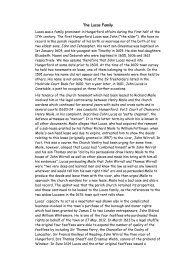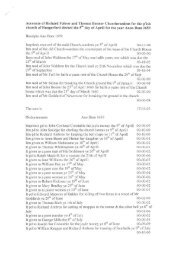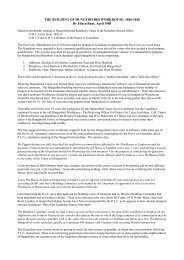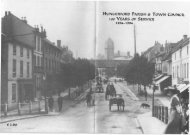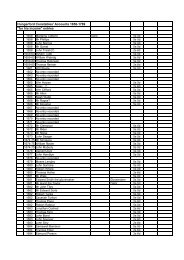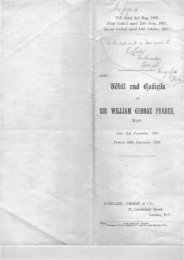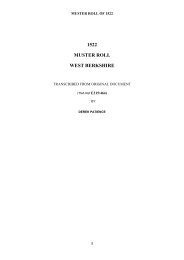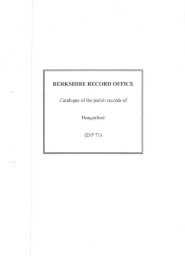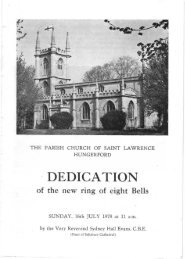The English Country House and Chilton Lodge - Hungerford Virtual ...
The English Country House and Chilton Lodge - Hungerford Virtual ...
The English Country House and Chilton Lodge - Hungerford Virtual ...
You also want an ePaper? Increase the reach of your titles
YUMPU automatically turns print PDFs into web optimized ePapers that Google loves.
As early as 1945, some owners of large houses (Thynnes at Longleat, the Russells at<br />
Woburn <strong>and</strong> the Montagus at Beaulieu) had seen that the way ahead was to throw open<br />
the doors of their stately homes <strong>and</strong> welcome an increasingly interested, educated <strong>and</strong><br />
mobile population. A very few families, such as the Cavendishes at Chatsworth, had<br />
always made a virtue of allowing <strong>and</strong> encouraging access to their houses. However, the<br />
originators of the accessible country house were the exceptions rather than the rule. Not<br />
only were they endowed with plenty of entrepreneurial flair, but also their houses were<br />
also mostly very large <strong>and</strong> were stuffed with treasures. <strong>The</strong>y also had the resources to<br />
develop other attractions.<br />
<strong>The</strong> turning point for the ECH probably came in 1974 with the exhibition at the V&A <strong>The</strong><br />
Destruction of the <strong>Country</strong> <strong>House</strong>'. Penal taxation, rampant inflation <strong>and</strong> increasingly<br />
bureaucratic intervention had been making life impossible for owners for two generations.<br />
However, prosperity was slowly returning to Britain <strong>and</strong> with it, the first glimmerings of a<br />
more enlightened attitude to taxation. <strong>The</strong> old order was well <strong>and</strong> truly dead, <strong>and</strong> Britain<br />
was becoming less socially divisive. 'Heritage' became the buzzword, tourism was<br />
increasing, <strong>and</strong> the owners of ECH's finally started to behave in a cohesive <strong>and</strong> concerted<br />
manner. Perhaps there was room after all for the country house to survive.<br />
CHILTON LODGE<br />
#2<br />
A few statistics.<br />
• <strong>The</strong> main accommodation areas in the house cover 1,996 sq.m., with a further 1,358<br />
sq.m. of attics <strong>and</strong> cellars. <strong>The</strong> outbuildings that form part of the property extend to a<br />
further 1,320 sq.m. <strong>and</strong> include three self-contained flats, a total of 4,673 sq.m. of<br />
buildings, all listed Grade 2 or 2*.<br />
• <strong>The</strong> house has five principal bedroom suites, two dressing rooms <strong>and</strong> three children's<br />
bedrooms.<br />
• We have a full-time housekeeper <strong>and</strong> a lady who comes in every weekday <strong>and</strong> a fulltime<br />
gardener.<br />
• We use about 30,000 litres of heating oil a year.<br />
<strong>The</strong>re was certainly a house called <strong>Chilton</strong> Park by 1595, when it was owned by Sir<br />
Thomas Hinton, Sheriff of Berkshire <strong>and</strong> Commissioner of Wool. <strong>The</strong> original house was<br />
in Wiltshire, just to the east of where Park Farm now st<strong>and</strong>s. I am afraid I have been<br />
unable to locate a picture of the original house.<br />
By the mid-17C, the property was owned by the splendidly named Sir Bulstrode<br />
Whitelocke, a Parliamentarian <strong>and</strong> diarist. He is notable for having had three wives <strong>and</strong><br />
13 children, <strong>and</strong> for having survived the Restoration, apparently changing sides with the<br />
same ease as he changed wives. However, his management of his personal affairs was<br />
somewhat erratic <strong>and</strong> <strong>Chilton</strong> was eventually sold to Mr. Holwell, a nabob who was a<br />
survivor of the Black Hole of Calcutta.<br />
It was later sold to John Pearse, MP, who was making a fortune from gun cotton in the<br />
Napoleonic Wars. It is with him that this story of <strong>Chilton</strong> really starts. Last week I<br />
discovered (on the Internet!) that a man of the same name was the Governor of the Bank<br />
of Engl<strong>and</strong> between 1810-12. I wonder if it was our Mr. Pearse.<br />
#3<br />
In any event, he seems to have been a man of considerable means <strong>and</strong> was already a<br />
client of John Soane when he bought <strong>Chilton</strong>. Immersed in classicism, but extremely<br />
radical in many ways, Soane was one of the most important architects of his generation.<br />
He had designed a substantial house for Mr. Pearse in Lincoln's Inn Fields, complete with<br />
stables, <strong>and</strong> was subsequently commissioned to design a new villa at <strong>Chilton</strong> on the site<br />
of the 16C house. Construction started in 1789 <strong>and</strong> was still in process in 1793. <strong>The</strong>




